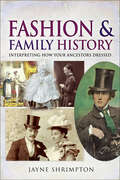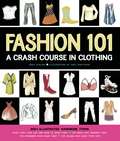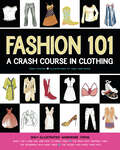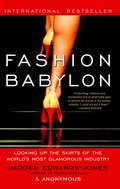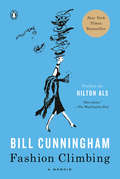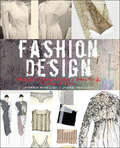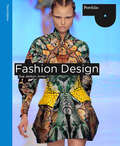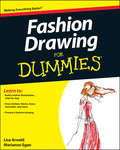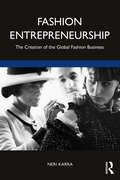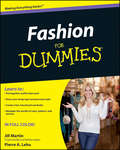- Table View
- List View
Fashion & Family History: Interpreting How Your Ancestors Dressed (Tracing Your Ancestors)
by Jayne ShrimptonThis illustrated volume explores what fashion history can reveal about the lives of your British ancestors.As Britain evolved from an agrarian society into an urban-industrial nation, dress was transformed. Traditional rural styles gave way to modern city modes, workwear, and holiday attire. Women sewed at home, while advanced textiles and mass-produced goods brought affordable fashion to ordinary people. Many of our predecessors worked as professional garment-makers, laundresses or in other related trades—and they used those skills when caring for their own clothes.The Victorians observed strict etiquette through special costumes for Sundays, marriage, and mourning. Poorer families struggled to maintain standards while young single workers spent their wages on clothes and the older generation cultivated their own discreet style. Twentieth-century dress grew more relaxed and democratic as popular culture influenced fashion for recent generations who enjoyed sports, cinema, music, and dancing.
Fashion & Sustainability: Design For Change
by Kate FletcherThis book examines how sustainability has the potential to transform both the fashion system and the innovators who work within it.Sustainability is arguably the defining theme of the twenty-first century. The issues in fashion are broad-ranging and include labour abuses, toxic chemicals use and conspicuous consumption, giving rise to an undeniable tension between fashion and sustainability. The book is organized in three parts. The first part is concerned with transforming fashion products across the garment's lifecycle and includes innovation in materials, manufacture, distribution, use and re-use. The second part looks at ideas that are transforming the fashion system at root into something more sustainable, including new business models that reduce material throughput. The third section is concerned with transforming the role of fashion designers and looks to examples where the designer changes from a stylist or creator into a communicator, activist or facilitator.
Fashion & Sustainability: Design for Change
by Lynda Grose Kate FletcherThis book examines how sustainability has the potential to transform both the fashion system and the innovators who work within it.Sustainability is arguably the defining theme of the twenty-first century. The issues in fashion are broad-ranging and include labour abuses, toxic chemicals use and conspicuous consumption, giving rise to an undeniable tension between fashion and sustainability. The book is organized in three parts. The first part is concerned with transforming fashion products across the garment's lifecycle and includes innovation in materials, manufacture, distribution, use and re-use. The second part looks at ideas that are transforming the fashion system at root into something more sustainable, including new business models that reduce material throughput. The third section is concerned with transforming the role of fashion designers and looks to examples where the designer changes from a stylist or creator into a communicator, activist or facilitator.
Fashion 101
by Erika StalderEach year, we spend hours upon hours shopping and getting dressed, but do we ever actually think about what we're wearing? For example, what's the name of the style of your shirt? Who invented your favorite jeans cut? Or who made your baby-doll nightie famous? There is a story behind every piece of clothing and, with Fashion 101, you'll learn what those stories are and more: Where did the miniskirt come from? Why has the military had a stronger influence on fashion than either Audrey Hepburn or Gwen Stefani? How do denim makers work those perfect "whiskers" into your "worn-out" jeans? Filled with tons of intriguing factoids about designers and celebrities, and more than 300 illustrations, Fashion 101 offers the total scoop on underwear, outerwear, accessories, and everything in between. With this crash course, you'll learn not only how to put together smarter looks, but also how to become a fashion expert in the process.
Fashion 101: A Crash Course in Clothing
by Erika StalderWe spend hours shopping and dressing, but do we think about what we're wearing? What's the style of your shirt called? Who made your baby-doll nightie famous? There is a story behind every piece of clothing and with Fashion 101 you'll learn: Where did the miniskirt come from? Why has the military had a stronger influence on fashion than Audrey Hepburn? Filled with intriguing factoids about designers and celebrities and more than three hundred illustrations, Fashion 101 offers the scoop on underwear, outerwear, accessories, and everything in between. With Fashion 101, you'll learn how to put together smarter looks and become a fashion expert in the process.
Fashion Babylon
by Anonymous Imogen Edwards-JonesWhat is fashion? What is fashionable? Who decides what's in and what's out? Why is it green one year and blue the next? Why is one little black dress worth five thousand dollars and another worth fifty? Is the catwalk really that catty? What makes a supermodel so super? And a designer too hot to touch? Who is making money? Who owns whom? Who hates whom? And who's in each other's pockets? The answers are all to be found in Fashion Babylon. Taking the reader through six months in a designer's life, it explains how a collection is put together -- from the objects of inspiration to the catwalk, into the shops and, hopefully, onto the cover of a magazine. It examines who goes to the shows and where they sit...and whose backside they have to kiss to get there. Narrated from the point of view of an anonymous A-list British fashion designer looking to break out across the pond and structured around three of the annual "must" industry events in London, Paris and New York, this irresistible work of reportage goes inside the well-cut seams of the fashion world, where women are paid tens of thousands of dollars for simply getting dressed and where a wrong skirt length can cost you your career. Fashion Babylon decodes the markups and the comedowns, the fabulous extremes and the shoddy shortcuts behind one of the most lucrative and secretive businesses in the world. Witty, naughty and packed with celebrity gossip, this book will forever change the way you peruse the racks at Bergdorf's or flip through the pages of Vogue.
Fashion Babylon
by Anonymous Imogen Edwards-JonesWhat is fashion? What is fashionable? Who decides what's in and what's out? Why is it green one year and blue the next? Why is one little black dress worth five thousand dollars and another worth fifty? Is the catwalk really that catty? What makes a supermodel so super? And a designer too hot to touch? Who is making money? Who owns whom? Who hates whom? And who's in each other's pockets? The answers are all to be found in Fashion Babylon. Taking the reader through six months in a designer's life, it explains how a collection is put together -- from the objects of inspiration to the catwalk, into the shops and, hopefully, onto the cover of a magazine. It examines who goes to the shows and where they sit...and whose backside they have to kiss to get there. Narrated from the point of view of an anonymous A-list British fashion designer looking to break out across the pond and structured around three of the annual "must" industry events in London, Paris and New York, this irresistible work of reportage goes inside the well-cut seams of the fashion world, where women are paid tens of thousands of dollars for simply getting dressed and where a wrong skirt length can cost you your career. Fashion Babylon decodes the markups and the comedowns, the fabulous extremes and the shoddy shortcuts behind one of the most lucrative and secretive businesses in the world. Witty, naughty and packed with celebrity gossip, this book will forever change the way you peruse the racks at Bergdorf's or flip through the pages of Vogue.
Fashion Babylon
by Imogen Edwards-JonesWhat is fashion? What is fashionable? Who decides what's in and what's out? Why is it green one year and blue the next? Why is one little black dress worth five thousand dollars and another worth fifty? Is the catwalk really that catty? What makes a supermodel so super? And a designer too hot to touch? Who is making money? Who owns whom? Who hates whom? And who's in each other's pockets? The answers are all to be found in Fashion Babylon. Taking the reader through six months in a designer's life, it explains how a collection is put together -- from the objects of inspiration to the catwalk, into the shops and, hopefully, onto the cover of a magazine. It examines who goes to the shows and where they sit... and whose backside they have to kiss to get there. Narrated from the point of view of an anonymous A-list British fashion designer looking to break out across the pond and structured around three of the annual "must" industry events in London, Paris and New York, this irresistible work of reportage goes inside the well-cut seams of the fashion world, where women are paid tens of thousands of dollars for simply getting dressed and where a wrong skirt length can cost you your career. Fashion Babylon decodes the markups and the comedowns, the fabulous extremes and the shoddy shortcuts behind one of the most lucrative and secretive businesses in the world. Witty, naughty and packed with celebrity gossip, this book will forever change the way you peruse the racks at Bergdorf's or flip through the pages of Vogue.
Fashion Bags and Accessories: Creative Design and Production
by Darla-Jane GilroyFashion Bags and Accessories explores fashion bags and related accessories, such as purses, wallets, clutches, cases, gloves and belts, through various approaches to creative design, product development, technological innovation, materials development, component design (hardware) and branding. Readers will become familiar with key constructions and gain grounding in both traditional craft-making techniques and contemporary digital manufacturing process. Traditional accessory materials like leather are considered alongside new and emerging sustainable materials. Key elements of fashion bags and accessories like component design, signature branding and logo design are also covered in depth. Primarily aimed at students on fashion design, product design, or specialized accessories courses, the book will also be a go-to reference for professionals wishing to move into or evolve in this product area.
Fashion Bags and Accessories: Creative Design and Production
by Darla-Jane GilroyFashion Bags and Accessories explores fashion bags and related accessories, such as purses, wallets, clutches, cases, gloves and belts, through various approaches to creative design, product development, technological innovation, materials development, component design (hardware) and branding. Readers will become familiar with key constructions and gain grounding in both traditional craft-making techniques and contemporary digital manufacturing process. Traditional accessory materials like leather are considered alongside new and emerging sustainable materials. Key elements of fashion bags and accessories like component design, signature branding and logo design are also covered in depth. Primarily aimed at students on fashion design, product design, or specialized accessories courses, the book will also be a go-to reference for professionals wishing to move into or evolve in this product area.
Fashion Climbing: A Memoir with Photographs
by Hilton Als Bill CunninghamThe untold story of a New York City legend's education in creativity and styleFor Bill Cunningham, New York City was the land of freedom, glamour, and, above all, style. Growing up in a lace-curtain Irish suburb of Boston, secretly trying on his sister's dresses and spending his evenings after school in the city's chicest boutiques, Bill dreamed of a life dedicated to fashion. But his desires were a source of shame for his family, and after dropping out of Harvard, he had to fight them tooth-and-nail to pursue his love. When he arrived in New York, he reveled in people-watching. He spent his nights at opera openings and gate-crashing extravagant balls, where he would take note of the styles, new and old, watching how the gowns moved, how the jewels hung, how the hair laid on each head. This was his education, and the birth of the democratic and exuberant taste that he came to be famous for as a photographer for The New York Times. After two style mavens took Bill under their wing, his creativity thrived and he made a name for himself as a designer. Taking on the alias William J.--because designing under his family's name would have been a disgrace to his parents--Bill became one of the era's most outlandish and celebrated hat designers, catering to movie stars, heiresses, and artists alike. Bill's mission was to bring happiness to the world by making women an inspiration to themselves and everyone who saw them. These were halcyon days when fashion was all he ate and drank. When he was broke and hungry he'd stroll past the store windows on Fifth Avenue and feed himself on beautiful things.Fashion Climbing is the story of a young man striving to be the person he was born to be: a true original. But although he was one of the city's most recognized and treasured figures, Bill was also one of its most guarded. Written with his infectious joy and one-of-a-kind voice, this memoir was polished, neatly typewritten, and safely stored away in his lifetime. He held off on sharing it--and himself--until his passing. Between these covers, is an education in style, an effervescent tale of a bohemian world as it once was, and a final gift to the readers of one of New York's great characters.
Fashion Design
by Denis Antoine Sue Jenkyn JonesThis introduction to fashion is aimed at students of fashion design across the world. By following the design process, from historical and commercial industry context to final collection presentation, the book provides a clear guide for students as they discover what designing for fashion entails. Along the way they will explore a wide variety of hands-on, creative methodologies of design ideation, development, and presentation. Supported by inspirational visual content—fashion photography, fashion illustration, sketchbook artwork, technical drawings, and infographics—and case studies, the book offers a unique overview of the fashion industry.
Fashion Design
by Kathryn Mckelvey Janine MunslowShows how the design process can be successfully applied to satisfy market needs and trendsFashion design seems to be a glamorous mystery for which only the fortunate few have sufficient talent to succeed. In reality, commercially successful results can be achieved if the right processes are followed in the early design process.Fashion Design sets out basic principles and exercises in order to make fashion design a logical process, providing a framework from which they can expand your skills steadily.Fashion Design, 2nd Edition:Shows how the design process can be successfully applied to satisfy market needs and trendsHas a problem solving approach, with practical design projects and portfolio exercises to encourage readers to develop their innovation, experimentation and versatilityPays special attention to computer-aided design (CAD) and employment opportunities, including an overview of what is involved in studying and becoming a designer in the contemporary fashion industry.
Fashion Design
by Sue Jenkyn Jones Sue JonesFashion Design is a primer on the industry for the twenty-first century, uniting history, theory, and practice in one indispensable book. Topics include the language of clothing, patterns, fabrics, and making techniques, how to build a collection and portfolio, and how to present on the catwalk and in the office. Perfect for aspiring designers, this describes the skills needed to become a fashion designer, discusses careers, and gives an inside view of the fashion business today.
Fashion Design Research
by Ezinma MbeledoguEvery fashion collection begins with research. But how do you start? How much should you do? How do you use that research? Fashion Design Research is designed to answer these questions and demystify the process for students.Illustrated throughout with inspirational photographs and images of good practice within student sketchbooks, the book begins with the basics of primary and secondary research sources and shows students how and where to gather information. Chapters on market, fabric and colour research are followed by the final chapter, which shows how to gather all the information together, understand it and use it in a process known as triangulation. Additionally, case studies from a wide range of international designers showcase different working methods.By offering a clear approach to research for fashion design, this book will inspire students to embrace an activity that is both fun and fruitful.
Fashion Design Research
by Ezinma MbonuEvery fashion collection begins with research. But how do you start? How much should you do? How do you use that research? Fashion Design Research is designed to answer these questions and demystify the process for students.Illustrated throughout with inspirational photographs and images of good practice within student sketchbooks, the book begins with the basics of primary and secondary research sources and shows students how and where to gather information. Chapters on market, fabric and colour research are followed by the final chapter, which shows how to gather all the information together, understand it and use it in a process known as triangulation. Additionally, case studies from a wide range of international designers showcase different working methods.By offering a clear approach to research for fashion design, this book will inspire students to embrace an activity that is both fun and fruitful.
Fashion Design Research Second Edition
by Ezinma MbeledoguEvery fashion collection begins with research. But how do you start? How do you use that research? Fashion Design Research answers these questions and demystifies the process. The book begins with the basics of primary and secondary research sources and shows students how and where to gather information. Chapters on colour, fabric and market research are followed by the final chapter on concept development, which shows how to gather all the information together, featuring one research project from beginning to end. This revised edition includes updated images and new case studies, plus more on ethics, sustainability and research methods.
Fashion Design Research Second Edition
by Ezinma MbeledoguEvery fashion collection begins with research. But how do you start? How do you use that research? Fashion Design Research answers these questions and demystifies the process. The book begins with the basics of primary and secondary research sources and shows students how and where to gather information. Chapters on colour, fabric and market research are followed by the final chapter on concept development, which shows how to gather all the information together, featuring one research project from beginning to end. This revised edition includes updated images and new case studies, plus more on ethics, sustainability and research methods.
Fashion Design for Living
by Alison GwiltFashion Design for Living explores the positive contribution that the contemporary fashion designer can make within society. The book seeks to reveal new ways of designing and making fashion garments and products that not only enhance and enrich our lives, but also are mindful of social and sustainable issues. This book sets out to question and challenge the dominant, conventional process of fashion design that as a practice has been under-researched. While the fashion designer in industry is primarily concerned with the creation of the new seasonal collection, designed, produced and measured by economically driven factors, society increasingly expects the designer to make a positive contribution to our social, environmental and cultural life. Consequently an emergent set of designers and research-based practitioners are beginning to explore new ways to think about fashion designing. The contributors within this book argue that fashion designing should move beyond developing garments that are just aesthetically pleasing or inexpensive, but also begin to consider and respond to the wearer's experiences, wellbeing, problems, desires and situations, and their engagement with and use of a garment. Fashion Design for Living champions new approaches to fashion practice by uncovering a rich and diverse set of views and reflective experiences which explore the changing role of the fashion designer and inspire fresh, innovative and creative responses to fashion and the world we live in.
Fashion Design, 3rd Edition (Portfolio)
by Sue Jenkyn JonesThis book offers a thorough grounding in the principles of fashion design, describing the qualities and skills needed to become a fashion designer, examining the varied career opportunities available and giving a balanced inside view of the fashion business today. Subjects covered include how to interpret a project brief; building a collection; choosing fabric; fit, cutting and making techniques; portfolio presentation; and fashion marketing and economics.This third edition has been totally redesigned and extensively updated, with new images showing the latest fashion trends and coverage of new techniques.
Fashion Design, 3rd edition
by Sue JenkynThis book offers a thorough grounding in the principles of fashion design, describing the qualities and skills needed to become a fashion designer, examining the varied career opportunities available and giving a balanced inside view of the fashion business today. Subjects covered include how to interpret a project brief; building a collection; choosing fabric; fit, cutting and making techniques; portfolio presentation; and fashion marketing and economics.This third edition has been totally redesigned and extensively updated, with new images showing the latest fashion trends and coverage of new techniques.
Fashion Design: A Guide To The Industry And The Creative Process
by Denis AntoineThis introduction to fashion is aimed at students of fashion design across the world. By following the design process, from historical and commercial industry context to final collection presentation, the book provides a clear guide for students as they discover what designing for fashion entails. Along the way they will explore a wide variety of hands-on, creative methodologies of design ideation, development, and presentation. Supported by inspirational visual content—fashion photography, fashion illustration, sketchbook artwork, technical drawings, and infographics—and case studies, the book offers a unique overview of the fashion industry.
Fashion Drawing For Dummies
by Lisa Arnold Marianne EganThe fast and easy way to learn the art of fashion drawingThis fun guide gives you dozens of step-by-step diagrams that walk you through the process of preparing creative illustrations that you can later develop into dynamic presentations for your design portfolio. Plus, you'll not only learn how to draw clothes and fabric, but also how to show details that make up the total look: faces and hairstyles, fashion accents, and a wide variety of textures.If you're an aspiring fashion designer, you know it's essential to be able to draw, prepare, and present a fashion drawing. Whether you have little or no prior drawing experience, Fashion Drawing For Dummies gives you easy-to-follow, non-intimidating instructions for mastering the drawing skills you need to design like a pro.Learn the rules and techniques of fashion drawingDraw the fashion figure in different poses and from multiple anglesDiscover how to complement your drawings with accessories, clothing, and styleIf you're a fledgling designer looking for non-intimidating guidance on learning the ins and outs of fashion drawing, this friendly guide has you covered!
Fashion Entrepreneurship: The Creation of the Global Fashion Business
by Neri KarraFashion generates over a trillion dollars in sales annually and has the priceless ability to beguile its customers around the world. Fashion Entrepreneurship: The Creation of the Global Fashion Business provides the first authoritative history of the global fashion industry, from its emergence to the present day, with a focus on the entrepreneurs at the nucleus of many of the world’s influential brands. It shows how successive generations of entrepreneurs built and developed their brands, democratizing access to fashion brands throughout the world. This book analyzes the careers of the greatest fashion entrepreneurs from the nineteenth century onward, including such legendary names as Charles Worth, Coco Chanel, Christian Dior, Yves Saint Laurent, and Giorgio Armani. It shows how this distinct form of entrepreneurship has arisen and what lessons new entrepreneurs can learn from the past to create thriving fashion businesses in today’s rapidly changing modern world. Filled with fascinating stories from the world of fashion, as well as detailed business analysis and practical advice for people looking to create successful brands, Fashion Entrepreneurship is an essential read for students of fashion and entrepreneurship, and anyone looking to understand, and succeed in, this most glamorous of industries.
Fashion For Dummies
by Pierre A. Lehu Jill MartinYour full-color guide to building a fun, functional wardrobeFashion For Dummies takes the guess out of dress, giving you the confidence and know-how you need to dress for every occasion. This full-color guide is packed with tips on creating a confusion-free wardrobe that works with your body type and personal style, as well as navigating the worlds of color, pattern, and texture.Reveals how to put together outfits that work without overextending your budgetFeatures a section dedicated to menswearPacked with helpful illustrations presented in full colorThe perfect guide for novice fashion-hunters, Fashion For Dummies is your key to always dressing your best!
